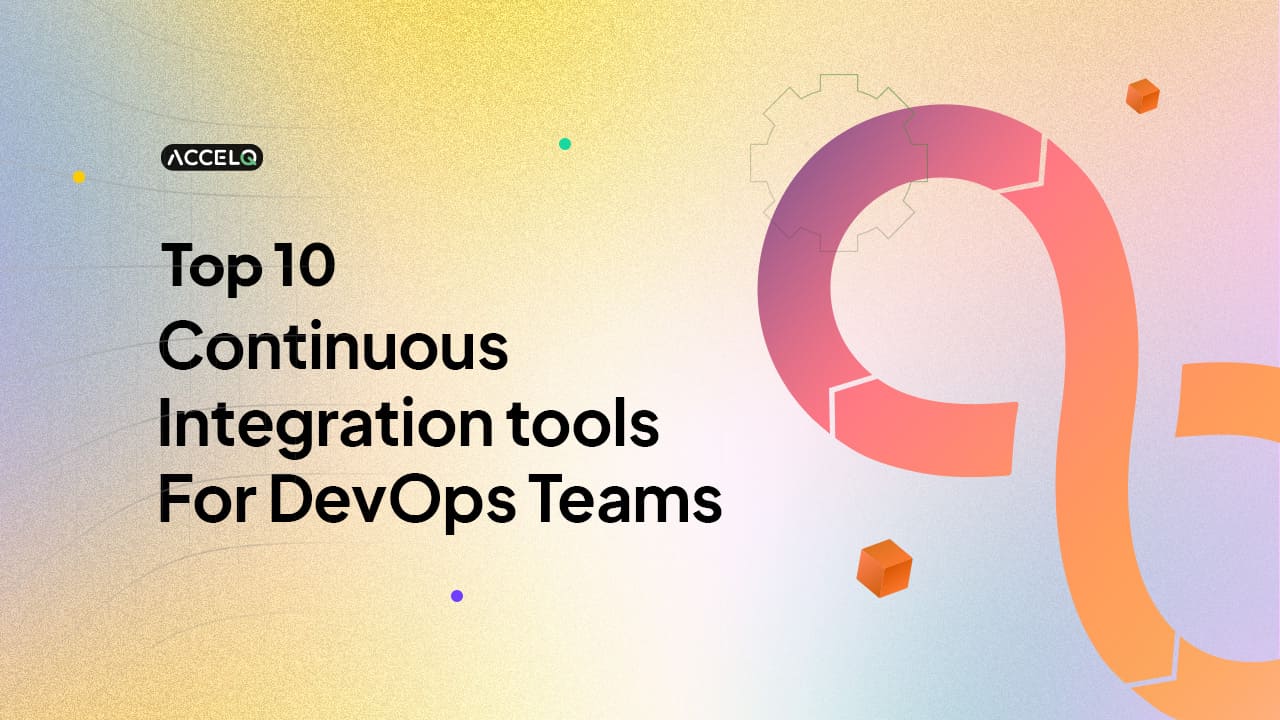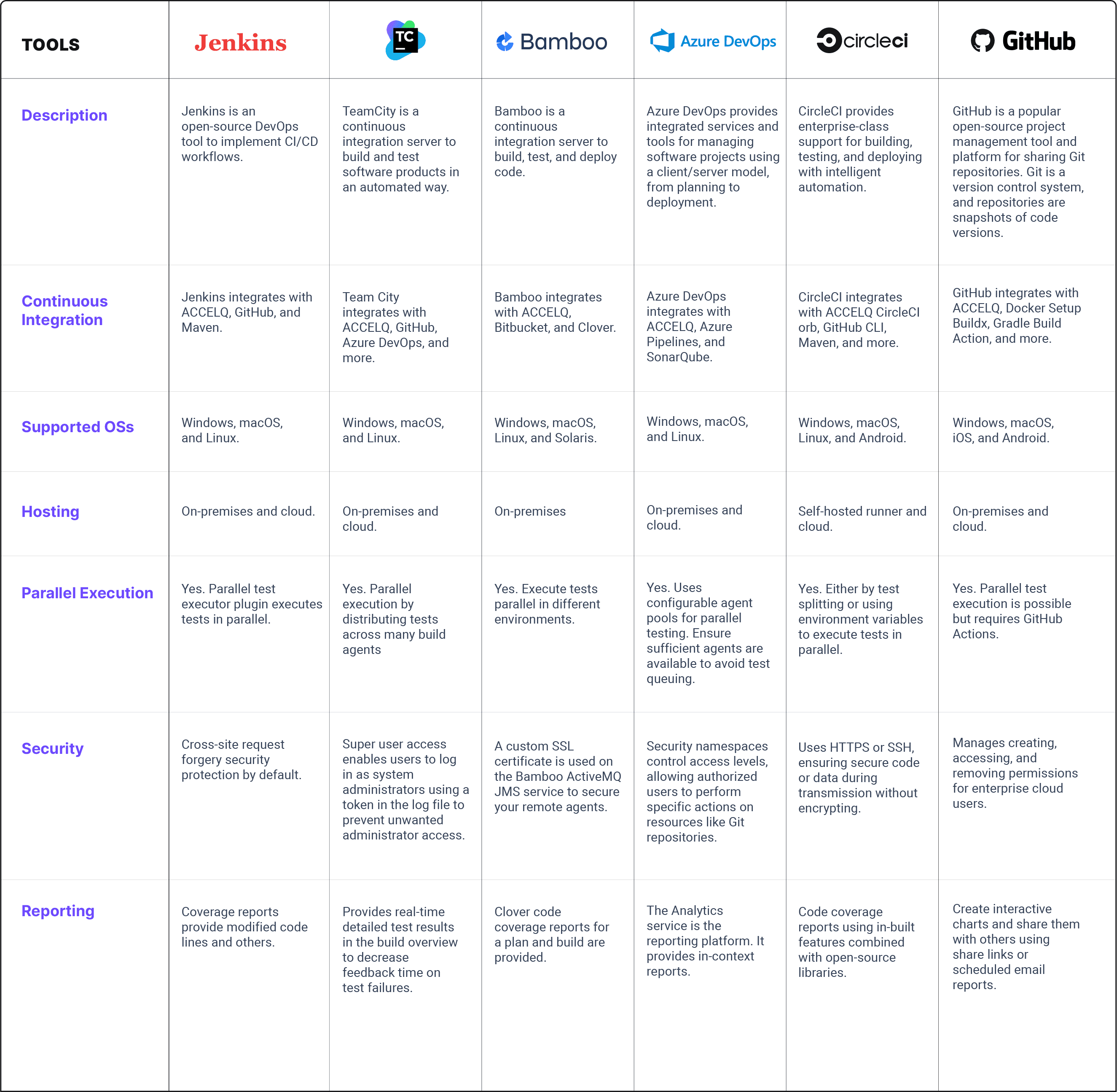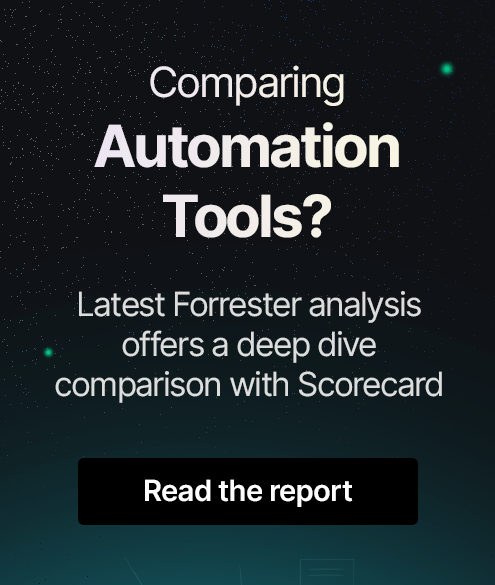Top 10 Continuous Integration Tools In 2025
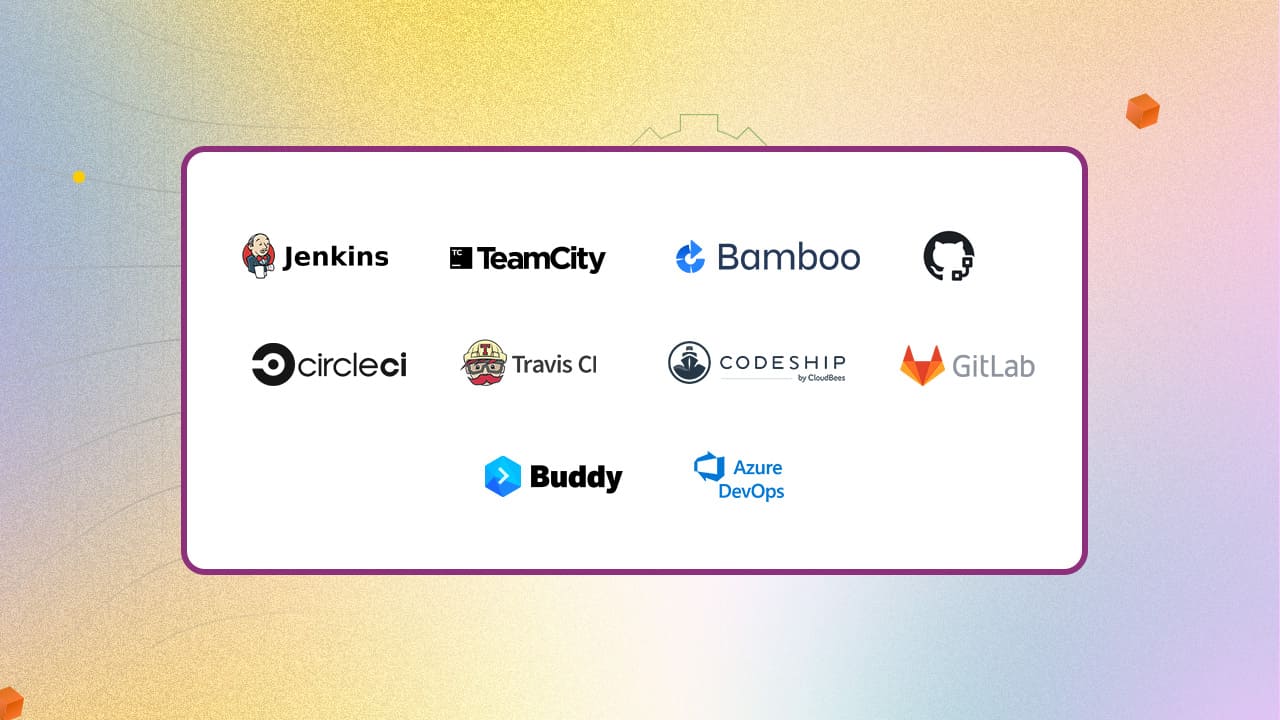
Continuous integration involves code changes, automated builds, and tests for reliable code merges. Continuous delivery (CD) automates code deployment to testing and development environments. Code changes that pass automated tests go to production in continuous deployment for frequent updates. The CI/CD pipeline automates the process for rapid, reliable delivery of code changes from development to production. What are your top preferred continuous integration (CI) tools in 2025 from the below list? Continuous integration helps to manage and change code by finding and fixing issues using the tools below for better code.
List Of Best Continuous Integration Tools
1. Jenkins

Jenkins is a self-contained, open-source automation server. It can build, test, and deploy software tasks. Jenkins can be installed from packages like Docker or run standalone on any machine with a JRE installed. The article on Jenkins CI test execution explains how to set up the ACCELQ automation step.
Features:
- Jenkins provides hundreds of plugins to build, deploy, and automate any project.
- The automation server, Jenkins, can easily be configured with its web interface.
- Jenkins can easily distribute work across many machines for faster testing and deployment.
- This automation server has many plugins and can integrate with all CI/CD toolchains.
- Jenkins is a self-contained Java-based program with Windows, macOS, and other Oses packages.
2. TeamCity

TeamCity is a CI solution that allows flexible workflows, collaboration, and development practices. Installation is available on-premises or as a cloud service. TeamCity on-premises can be installed on Windows, Linux, and macOS, while TeamCity Cloud is powered by AWS. The article on TeamCity CI test execution covers setting up ACCELQ in your project.
Features:
- TeamCity has various build runners that integrate with tools used to build, test, and deploy software. When a test suite is run, the build runner understands what’s happening during the build, checks code coverage, and provides reports.
- Test parallelization divides tests into batches and executes in parallel when many build agents exist.
- TeamCity automates build and test processes for software development projects. It offers Amazon Web Services and more integrations to customize and expand build infrastructure. IDE integration provides rapid feedback.
- Pre-tested commits allow for remote verification of changes before committing to the VCS to prevent broken code.
- User management and authentication using hosting services like GitLab and Azure DevOps.
3. Bamboo

Bamboo is an automation server used for continuous integration. It is a CI/CD pipeline offering reliability and scalability for teams. It allows developers to automatically build, document, integrate, test the source code, and deploy an app. It is flexible, can be used on various tools, has an easy-to-use graphical user interface, and allows developers to use CI/CD methodologies. The article on Bamboo CI test execution describes setting up the ACCELQ automation step.
Features:
- Bamboo can be connected to Atlassian cloud products with application tunnels.
- Change detection performance has improved in the Bamboo 9.3.
- Accessibility has been improved for low-vision and keyboard-only users after releasing Bamboo 9.4.
- With the Universal Plugin Manager in release 9.4, Bamboo doesn’t ship with the JDBC driver for the database engine.
- Database credentials are secured with AWS Secrets Manager after the release of Bamboo 9.5.
4. GitHub Actions

GitHub Actions makes automating all software workflows with CI/CD easy. Build, test, and deploy code right from GitHub. Make code reviews, branch management, and issue triaging work as you want. The article on GitHub Actions CI integration explains how to integrate ACCELQ.
Features:
- GitHub Actions supports Node.js, Python, Java, Ruby, PHP, Go, Rust, .NET, and more. Build, test, and deploy applications in your preferred language.
- Matrix workflows save time by testing across many operating systems and versions of runtime.
- GitHub Actions supports multi-container testing. It tests the web service and its DB in your workflow by adding some docker-compose to your workflow file.
- Live logs of the workflow run are provided. You can click a link highlighting a specific line number to share the CI/CD failure.
- GitHub Actions connects all your tools to automate every step of the development workflow. Easily deploy to any cloud and create tickets in Jira.
5. CircleCI

CircleCI was built by DevOps professionals. It helps to fine-tune the entire development process from start to finish. CircleCI provides enterprise-class support and services. The article on CircleCI CI test execution details ACCELQ CircleCI Orb parameters.
Features:
- Workflows make testing fast through quick feedback, shorter reruns, and efficient use of resources.
- The Insights dashboard provides an overview of the usage of projects’ build processes. It includes aggregated data on success rates and pipeline duration.
- CircleCI supports authentication via OpenID Connect at the job level. This CI/CD tool meets the rigorous FedRAMP and SOC 2 Type II standards.
- Tools can connect to the source code repository with CircleCI. Or use orbs to add pre-packaged configurations for third-party services like Slack and AWS.
- CircleCI supports Docker, Linux, Windows, macOS, and Android execution environments on the cloud.
6. TravisCI

TravisCI is a cloud-hosted continuous integration (CI)service. It can seamlessly integrate with GitHub repositories. TravisCI automatically triggers builds and tests upon code changes, pull requests, or other events.
Features:
- TravisCI supports testing on Mac, Linux, and iOS.
- TravisCI automates validation, integration, and deployment tasks with one command. It supports over 30 programming languages.
- A build matrix is made up of several jobs that run in parallel. Build Matrix reduces the build execution time and runs tests against different versions of runtimes.
- TravisCI automatically catches, fixes bugs, and deploys new changes.
- TravisCI offers dozens of ready-made integrations with tools like HashiCorp Vault and SonarCloud.
7. CodeShip

CodeShip is a SaaS solution that optimizes continuous integration and continuous deployment. It can develop web apps and modern microservice architectures for faster, more secure, and more frequent code delivery. Due to its simplicity and flexibility, CodeShip will be useful for growing software development needs.
Features:
- CodeShip is a CI/CD solution optimized for Kubernetes-managed platforms like OpenShift.
- Auto-configuring and scaling the agent pool can manage controllers for cloud scalability. CodeShip is capable of managing enterprises across clusters and cloud providers. It also includes hibernating idle controllers to conserve resources.
- ServiceNow can be integrated by this SaaS solution into your Jenkins Pipeline for change management.
- CodeShip meets the Department Of Defence (DoD) specifications to lower security risks.
- Jenkins credentials are stored in an external CyberArk vault. Organize teams, infrastructure, and credentials with Folders Plus features. Throttle builds during high loads with the Label Throttle Build feature.
8. GitLab

GitLab is a comprehensive AI-powered DevSecOps platform. DevSecOps is a blend of development, security, and operations. It is a software development approach that integrates security across the development lifecycle.
Features:
- GitLab brings DevSecOps capabilities into one application with a unified data store so everything is in one place.
- AI can enhance efficiency and reduce cycle times at every stage of the software development lifecycle.
- GitLab’s single application offers a user experience by improving cycle time. It also prevents context switching.
- Security capabilities such as fuzz testing, container scanning, and API screening are integrated from end to end.
- This platform offers a detailed governance solution that separates duties among teams. GitLab’s policy editor can create custom approval rules to meet compliance needs and reduce risk.
- GitLab’s advanced automation tools ensure code is automatically scanned for vulnerabilities.
- A unified data store offers analytics for the entire SDLC to reduce extra product integrations.
9. Buddy

Buddy is an automation platform that simplifies DevOps for developers and QA teams. Within minutes of setup, it can build, test, and deploy apps and websites faster. Buddy runs builds in customizable containers with ready-to-use environments for languages and frameworks.
Features:
- Buddy can configure delivery pipelines using the most user-friendly design.
- This automation platform builds, tests, and deploys apps and websites with 100 actions and zero scripting.
- Easy configuration via GUI and update with a few clicks.
- Buddy supports every tech and framework, from serverless deployment to Docker and Kubernetes.
- Preview websites in dynamic staging environments to launch directly from Git.
- Buddy operates on PCI-compliant architecture with two-factor authentication. It restricts workspace access to specific IP addresses.
10. Azure DevOps

The Azure DevOps platform is a collection of services that cover the entire software development lifecycle. The services include Azure Pipelines, Azure Repos, Azure Test Plans, and more. Azure Pipelines is cloud-based and can automatically build, test, and deploy with CI/CD, which works with any language and platform. Azure Repos provides unlimited, cloud-hosted, private, and public Git Repos. Azure Test Plans provide both manual and exploratory testing solutions. You can use all the services with Azure DevOps or opt for what you need to complement your existing workflows.
Features:
- Azure DevOps uses agents to specify a required resource for the pipeline.
- Artifacts support publishing or consuming different package types.
- Azure DevOps uses demands to meet pipeline requirements before running a pipeline stage. Demands need self-hosted agents.
- This platform offers dependencies to meet the specific requirements to run the next job or stage.
- Jobs define the execution sequence of a set of steps. Service connections enable a connection to a remote service to execute tasks in a job.
- Tasks define the building blocks that make up a pipeline. Triggers define the event that causes a pipeline to run.
- Variables represent values to be replaced by data and passed to the pipeline. Variable groups store values to control and make available across many pipelines.
Conclusion
Continuous integration tools integrate AI to optimize test automation and deployment pipelines. These tools enhance software products' efficiency, security, and adaptability. ACCELQ, an AI-powered test automation platform, integrates with Jenkins, TeamCity, and Bamboo. It supports CircleCI through the ACCELQ CircleCI orb. This codeless platform simplifies running automation scripts in CI pipelines without DevOps expertise.
Are you interested in a scalable CI/CD Azure pipeline? Contact us for a personalized demo to see how ACCELQ can help you.
Discover More
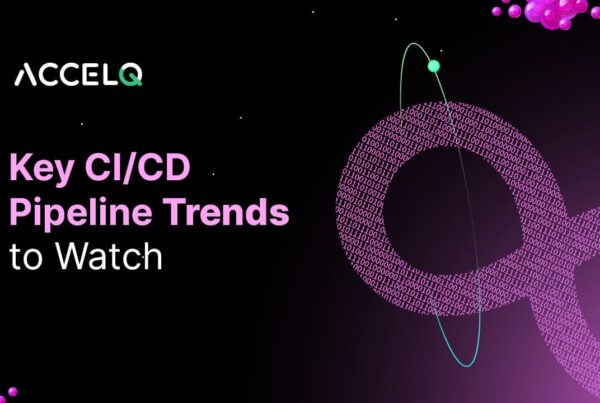 Key CI/CD Pipeline Trends to Watch in 2024
Key CI/CD Pipeline Trends to Watch in 2024
Key CI/CD Pipeline Trends to Watch in 2024
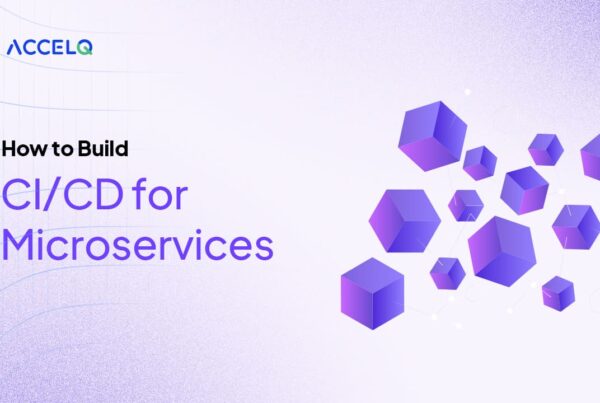 How to Build CI/CD for Microservices
How to Build CI/CD for Microservices






























